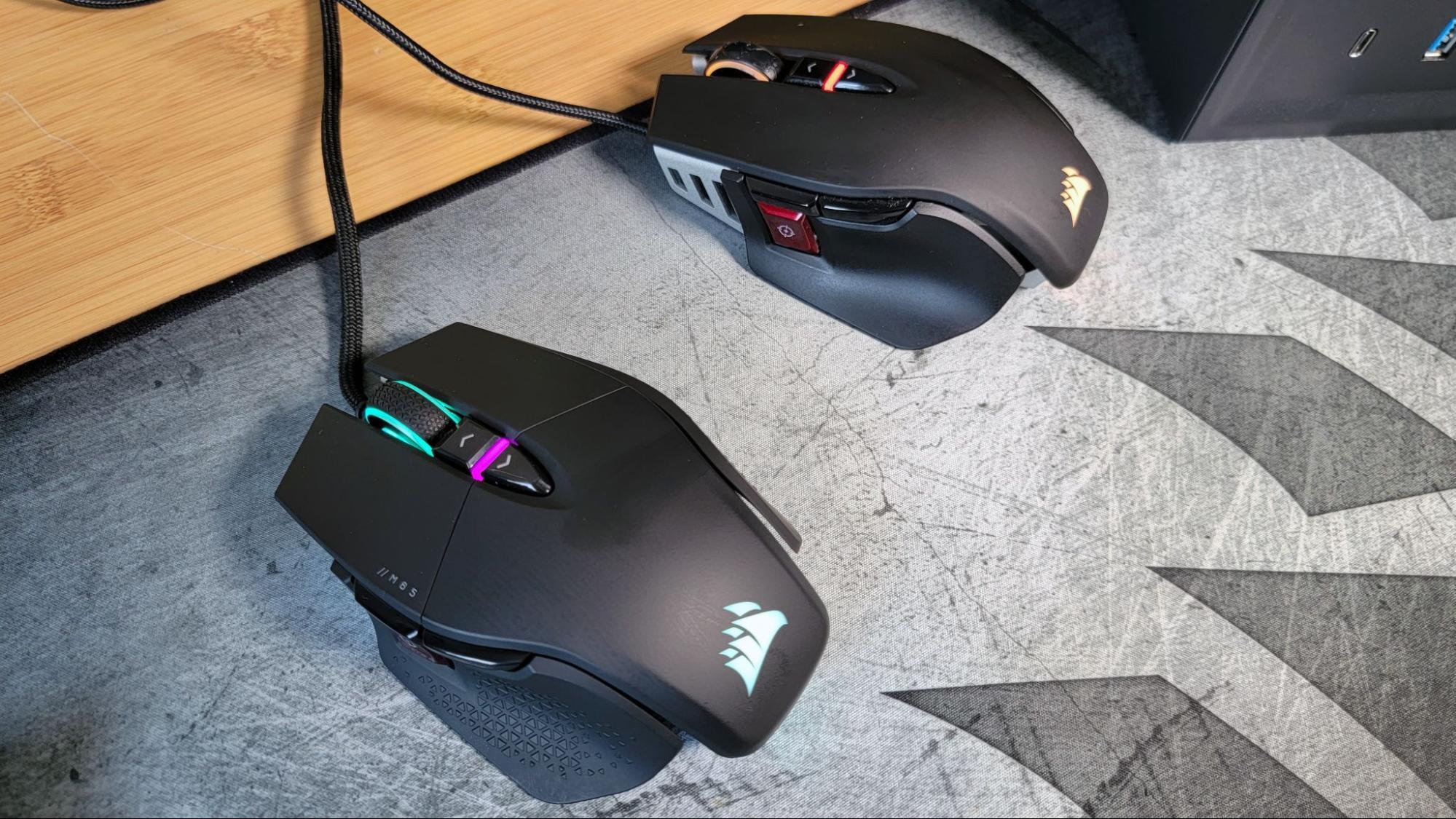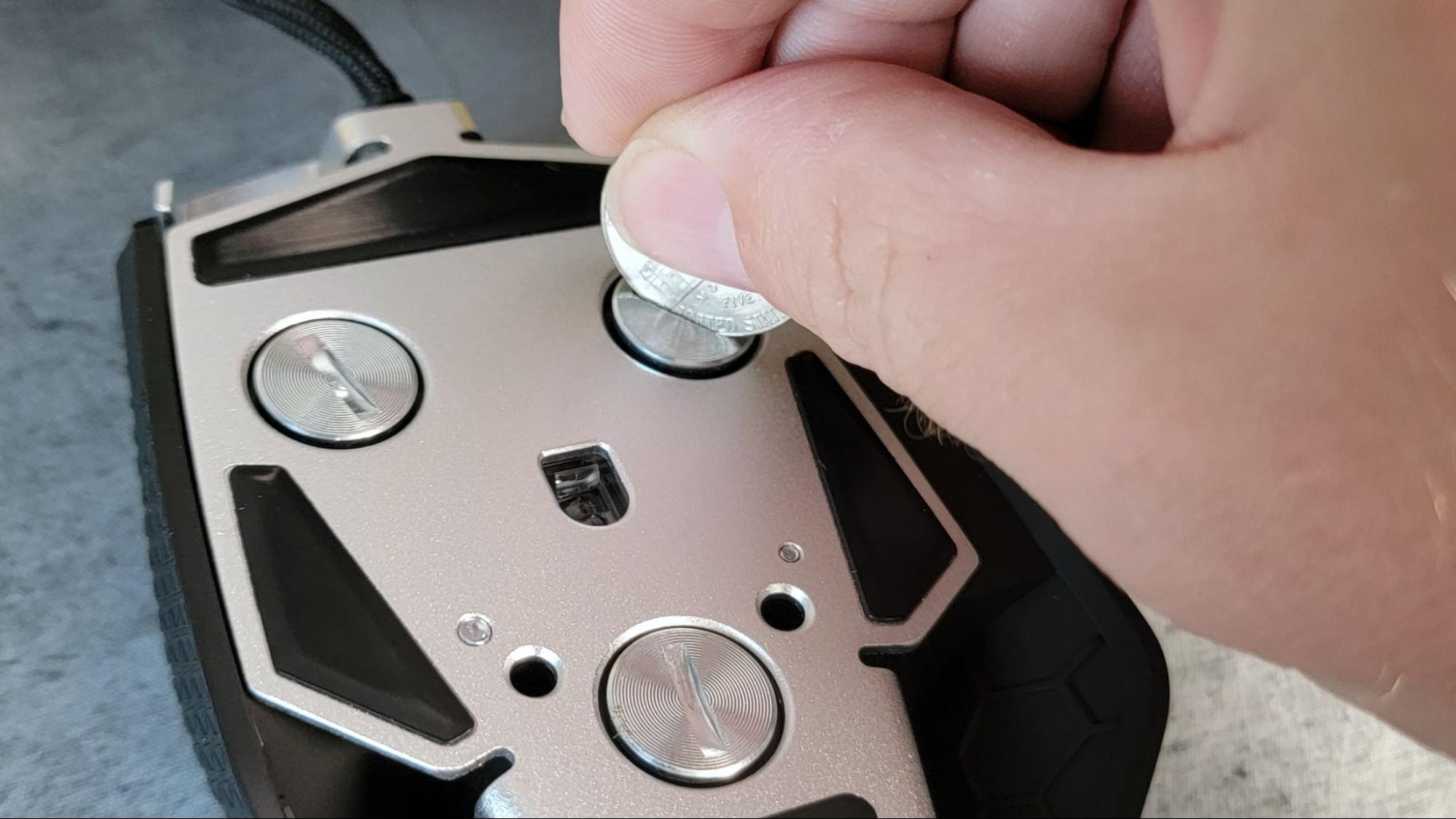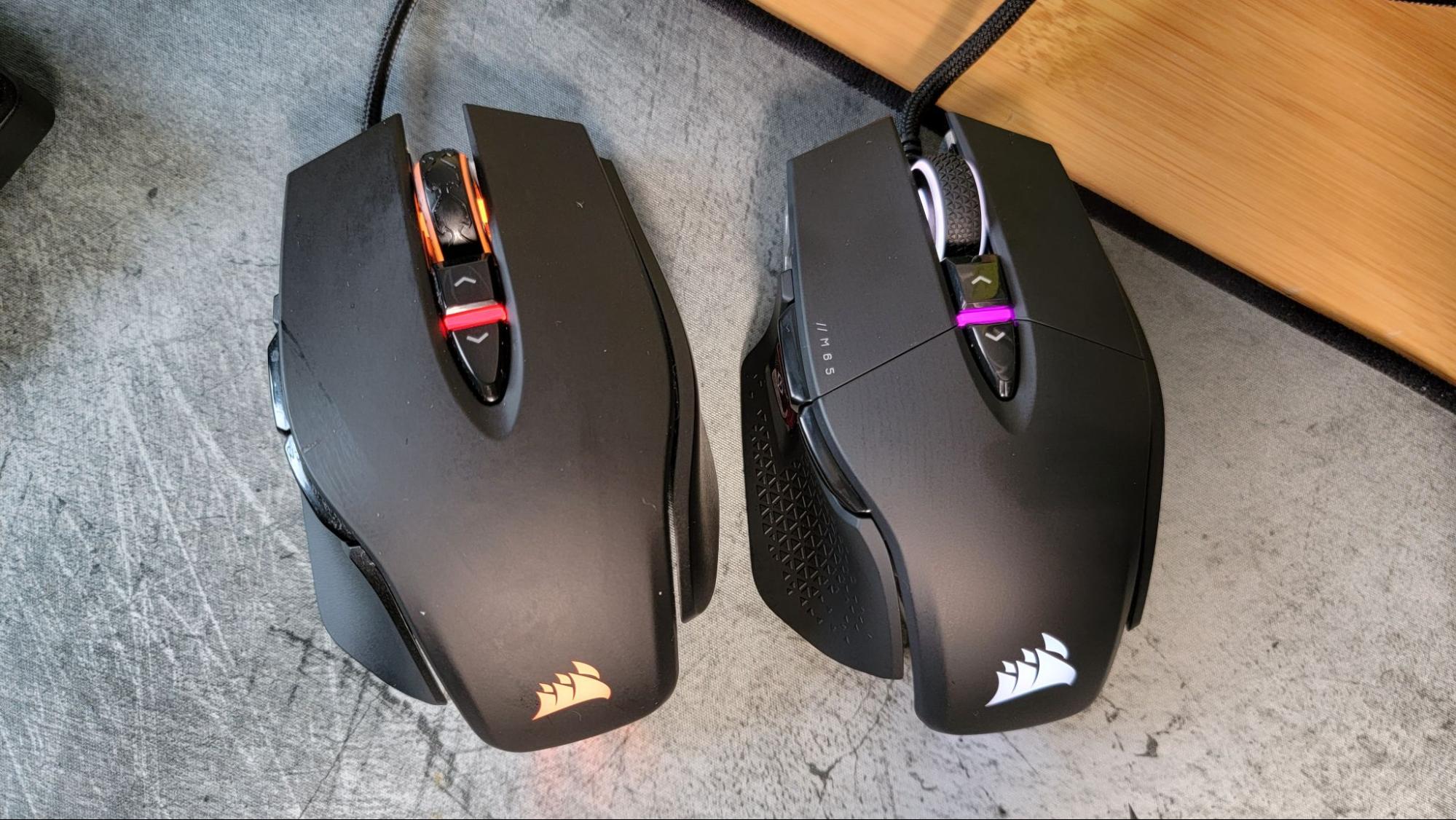Hands-On With Corsair’s M65 RGB Ultra Mouse: Upgrading an FPS Classic
Corsair’s FPS-focused M65 gaming mouse has been through many iterations, going all the way back to the original M60 from 2011 (although we first wrote about it in 2016 when it got an upgrade). Today the company is back with yet another update, in the form of the M65 RGB Ultra.
The aluminum frame, 8-button layout (including a big red sniper button) and handy thumb-resting shelf all share the same shape and placement as in previous models, which frankly, is fine because the mouse feels extremely solid and comfy. But the company has gutted the internals, installed a Marksman 26,000 DPI sensor and, in a trend that’s quickly becoming common in high-end mice, added 8,000 Hz polling support.
Corsair M65 RGB Ultra Specs
| Sensor Model | Marksman | Row 0 - Cell 2 |
| Max Sensitivity | 26,000 DPI | Row 1 - Cell 2 |
| Polling Rates | Up to 8,000 Hz | Row 2 - Cell 2 |
| Programmable Buttons | 8 | Row 3 - Cell 2 |
| LED Zones | 2 | Row 4 - Cell 2 |
| Cable | 6 feet (1.8m) paracord | Row 5 - Cell 2 |
| Connectivity | USB Type-A cable | Row 6 - Cell 2 |
| Measurements (LxWxH) | 5.08 x 2.76 x 1.69 inches (117.0 x 77.0 x 39.0 mm) | Row 7 - Cell 2 |
| Weight (excluding cable) | 3.42 ounces (97g) | Row 8 - Cell 2 |
Exterior Design of the Corsair M65 RGB Ultra
Corsair also made a couple of appreciated exterior changes over the previous 2019-era M65 Pro RGB. The older mouse (top right in the image above) had smooth sides and a modestly textured scroll wheel. The new M65 RGB Ultra has textured sides and a similar finish on the rubberized scroll wheel. These are subtle changes, but they're helpful — especially during long gaming sessions or during the summer when even the AC can’t keep your claw hand cool.
Corsair has also moved the mounting area for the cable from its previous position, a bit off to the left on the front of the Pro mouse, to the center on the newest Ultra model. I didn’t find this to make any difference in gameplay, but it certainly looks more natural.
Like previous models, the M64 RGB Ultra also has an adjustable weight system. Three sections on the bottom screw off, revealing weights that can be added to or removed, letting you adjust the rodent’s weight between 97 and 111 grams as well as adjusting its center of gravity. Personally, I like the mouse at its lightest, but it’s nice to have options.
If you’ve never used or owned one of the previous M65 iterations before, the M65 RGB Ultra is a medium-sized mouse (which I find perfect for my medium-sized hands), that is 117 mm front to back, 77 mm wide at its widest, and 39 mm tall.
The mouse features eight well-placed programmable buttons, including a big dedicated sniper button on the left to drop your DPI down for those precise headshots. The main left/right switches are made by Omron and use light rather than metal contact to trigger, for lower latency and faster actuation. Like Corsair’s other recent wired mice, it features a six-foot USB cable that’s wrapped in paracord, which feels a bit looser and lighter than more traditional braided cables.
Sensor and Mouse Tilt Gestures on the Corsair M65 RGB Ultra
If you buy into the basic notion that higher spec numbers make for a better mouse, the M65 RGB Ultra certainly delivers. Corsair’s Marksman optical sensor can be adjusted from 100 up to 26,000 DPI, either via the up/down buttons behind the scroll wheel or in single-integer increments via the company’s iCue software.
Speaking of those top DPI buttons, their placement is the one thing I don’t like about the mouse’s layout. They seem larger than necessary, and the rear one is so far back that my pointer finger needs to move pretty far from the scroll wheel to hit it.
On another note, serious FPS players often use low DPI settings for precise control, forcing them to often pick up and move their mouse back to the middle of their mousepad. To keep your aim steady during these movements, the Corsair M65 RGB Ultra also has gyroscopic lift detection. According to the company, the sensor “detects very fine mouse rotations occurring at the beginning of mouse repositioning” and instantly disables tracking, hopefully keeping your foe in your sights.
Interestingly, the six-axis motion sensor in the mouse has another benefit. You can map actions to four different “tilt gestures,” left, right, forward, and back. Obviously, tilting left or right is far easier than forward or back; forward, in particular, is cumbersome. But I found left and right pretty easy and intuitive. Corsair’s suggestions to use some of these gestures in games to reload or peek around a corner sound promising, as does the idea of using the gestures outside of games. But this is also a quite foreign type of mouse movement, and I didn’t have the M65 RGB Ultra long enough before having to write this up to really get used to using the gestures. Time will have to tell whether it’s a novel feature or something I’ll work into my everyday work/gameflow.
8,000 Hz Polling on the Corsair M65 RGB Ultra
Razer threw down the 8K polling gauntlet early this year with the Viper 8K, and Corsair soon followed with the 8,000 Hz Sabre RGB Pro, enabled by an SoC in the mouse that Corsair calls Axon. Given that most mice for years have been “stuck” at 1,000 Hz, 8,000 Hz certainly sounds like a major improvement. And indeed, Corsair claims the higher rate “registers and transmits your movements and clicks up to 8x faster.” Of course, the real question is whether most people’s movements and reactions are fast enough to benefit from a mouse pinging your PC 8x faster, or if 1,000 Hz is in fact enough.
Interestingly, the mouse comes out of the box running at just 1,000 Hz. You need to jump into the company’s iCue software to change that (you can also choose intermediate options like 2,000, 4,000, or even below 1,000).
Why not ship the mouse with what the company calls “hyper-polling” enabled by default? For starters, it’s because upping the times per second the mouse sends data back to your PC by 8x can have a surprising impact on your CPU cycles. You may need to upgrade your CPU to take full advantage of this feature. Corsair recommends a “recent generation Intel Core i7 or AMD Ryzen 7 processor” or similar. Given that the best gaming CPUs in terms of performance for your dollar are usually less-expensive Ryzen 5 and Core i5 CPUs (the Ryzen 5 5600X and Core i5-11600K are currently our two top choices), it’s probably safe to say most gamers’ rigs don’t quite meet the recommendations for 8,000 Hz.
Get Tom's Hardware's best news and in-depth reviews, straight to your inbox.
As I said when I tested the 8,000 Hz Sabre RGB Pro, at the very least you likely need to be a truly high-level gamer to get any appreciable benefit from the highest polling rate. I’d generally say the same for the high DPI settings as well, honestly. Some may benefit from super-high sensitivity settings but personally, trying to do anything with a mouse set much above 3,200 just feels like I (or at least my character) spent too long at the local pub. Plus, as stated earlier, serious FPS gamers often spend more time with the DPI settings set on low rather than high.
At any rate, as high-refresh monitors become more and more common, higher polling rates and sensor settings could be more beneficial down the line, when your CPU might have a bit more compute power to handle higher settings as well. And there’s nothing wrong with packing some future-proofing into a peripheral — especially one like the M65 RGB Ultra that feels solid enough to last several years.
Gaming Experience on the Corsair M65 RGB Ultra
Over the course of about a week, I put the Corsair M65 RGB Ultra to good use in a handful of FPS titles, including the beta of Doom Eternal, Borderlands 3 and the retro FPS Amid Evil. The mouse felt familiar and comfortable to me, likely in part because I’ve used previous iterations of the K65 before. But again, the only button that I found hard to press was the rear DPI toggle, which is nearly on the top center of the mouse. I’d likely either set that to some infrequently used action, or just pretend it wasn’t there.
I found the big red sniper button on the left side handy for dropping down the DPI and making headshots with long-range rifles. But to me at least it feels more like a fun thing to play with rather than a game-changing feature. Then again, if you’re into FPS games enough to buy a high-end mouse specifically designed for them, the sniper button (and some of the M65 RGB Ultra’s other features) might be worth paying for.
Pricing and Conclusion
Price is the Corsair M65 Pro’s primary sticking point. The 2019-era M65 Elite, which is basically the same mouse, sans the new sensor, textured side grips, and 8,000 Hz polling, is available at most major outlets for $50-$60. The new M65 RGB Ultra has an MSRP of $109.99. There’s also a wireless model coming for $129.99.
So you have to ask yourself if the latest high-DPI sensor, better grips and cutting-edge polling (which you may not even have the CPU cycles to handle) are worth paying so much extra for. The lesser model still has a still pretty great 18,000-DPI, mind you. Personally, I’d be fine sticking with the Elite model and spending the saved $60 on something else. The thing I’d miss the most would likely be the textured sides.
But clearly, I’m not a pro gamer, and the Corsair M65 Pro wasn’t made for me. My paltry new Ryzen 5 5600X CPU doesn’t even meet the mouse’s recommended specs for running at top speed. If you’re an FPS-focused gamer with the skills to compete with the best, a recent high-end CPU, and you’re looking for any edge you can get to rise up the ranks, the M65 Pro might be a worthy investment. But for the rest of us, the Elite model looks like a comparative steal at about 50 bucks.
After a rough start with the Mattel Aquarius as a child, Matt built his first PC in the late 1990s and ventured into mild PC modding in the early 2000s. He’s spent the last 15 years covering emerging technology for Smithsonian, Popular Science, and Consumer Reports, while testing components and PCs for Computer Shopper, PCMag and Digital Trends.
-
perseco I probably won't bother, as I doubt they bothered to fix the design flaws with the middle mouse button from the previous M65 mice.Reply





